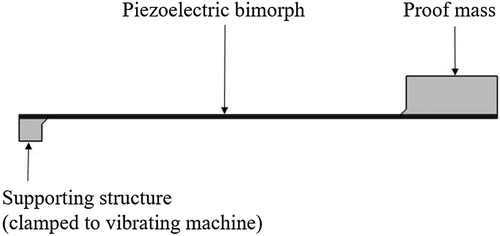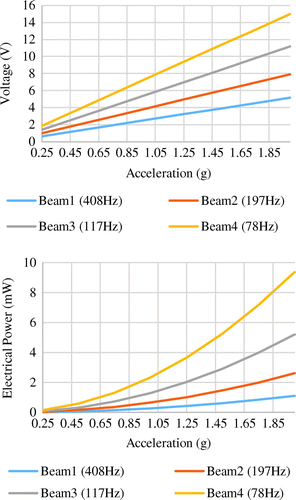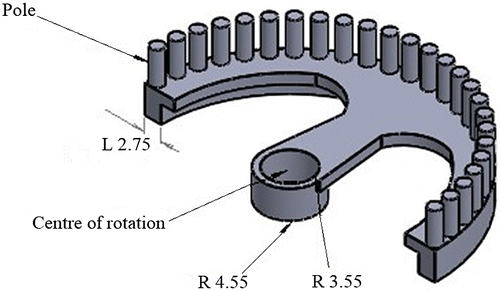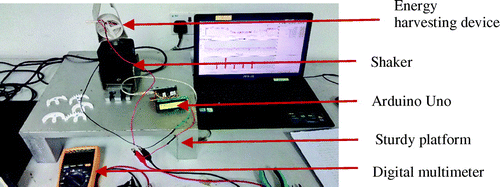 ?Mathematical formulae have been encoded as MathML and are displayed in this HTML version using MathJax in order to improve their display. Uncheck the box to turn MathJax off. This feature requires Javascript. Click on a formula to zoom.
?Mathematical formulae have been encoded as MathML and are displayed in this HTML version using MathJax in order to improve their display. Uncheck the box to turn MathJax off. This feature requires Javascript. Click on a formula to zoom.Abstract
Electronic devices are mostly powered externally via batteries. The dependency on the recharging process limits the usage of these devices to work in a specified period of time. This research work highlights the capability of a piezoelectric energy harvester to generate sufficient electricity to power up electronic devices by using low frequency vibrations alone, without relying on external power supplies. In general human motions consists of low frequency vibrations, therefore the capability to power up electronic devices using low frequency vibrations will also eventually become useful to power up wearable devices. Simulations were conducted using COMSOL Multiphysics® to identify the dimensions of a piezoelectric beam which will produce the optimum level of voltage output. A specially fabricated rotational piezoelectric energy harvester prototype that consists of a 40 mm piezoelectric bimorph beam that rotates with the aid of a rotor and aluminum proof-mass was developed together with a corresponding Arduino Uno based data logger. With a given input frequency of 18 Hz, the maximum voltage output that could be generated was recorded at 0.024 V. This research highlights the optimistic possibility that clean energy could be generated and utilized in powering various applications without depending on external power supplies.
Public Interest Statement
The number of wearable electronic devices used in a variety of applications of consumer electronics has been rapidly increasing over the years. The usage of these wearable devices depends on power supplied from batteries. Although batteries provide sufficient power supply, in the long run batteries are subject to ageing and lose their charge over time. Energy harvesting is an alternative means to power up wearable electronic devices other than batteries. In this paper a piezoelectric based rotational energy harvester is designed and developed for generating clean energy from low frequency motion without depending on batteries. The outcome from this research is useful not only for wearable devices, but also for other types of applications such as self-powered mobile sensors.
1. Introduction
With the advances of technology in miniaturization of electronic components, devices used for health monitoring activities have reduced in size, weight as well as power requirement. These devices, designed to be easily strapped onto users’ body part, allow them to comfortably conduct simple health monitoring activities on their own. There are many applications of wearable devices which have demonstrated the advantage of such devices as compared to mains powered electronic devices. The vital signs of body functions such as heart rate, breathing, blood pressure and temperature could be monitored for remote health monitoring by using wearable devices (Duun, Haahr, Birkelund, & Thomsen, Citation2010; Haahr et al., Citation2012; Kalantarian, Sideris, Mortazavi, Alshurafa, & Sarrafzadeh, Citation2017; Li, Mu, Yang, & Mason, Citation2014; Mansourkiaie, Ismail, Elfouly, & Ahmed, Citation2017; Soh & Vandenbosch, Citation2015). Measuring the pH of sweat provides a useful indication of dehydration risks and therefore dehydration could be identified and prevented at an early stage (Koh et al., Citation2016; Salvo, Di Francesco, Costanzo, Ferrari, & Trivella, Citation2010). Furthermore, the advent of physical activity trackers such as the apple watch and fitbit suggest that these miniature wearable electronic devices are increasingly becoming a part of our lives.
These multiple functionality devices however, require external electricity/batteries to power them up. As the number of the applications increases, the power consumption increases, consequently limiting the duration in which the device can be utilized. An apple watch, for example, has most of the applications of a normal mobile phone, with additional features such as heart rate monitoring. The apple watch has a built-in rechargeable Lithium-ion battery that can last up to 18 h (at very minimal application usage) before requiring it to be recharged (Apple Inc, Citation2017)
Energy harvesting has become a promising alternative for supplying energy to these electronic devices. Many works have been conducted in this area. Motion from the limbs can be utilized as an input to an energy harvester which will then be used to power up wearable devices. In recent years, many energy harvesting devices have been developed using MEMS technology (Jia & Seshia, Citation2016; Kim, Priya & Kanno, Citation2012; Mallick, Amann, & Roy, Citation2017; Mayrhofer et al., Citation2017; Mitcheson, Yeatman, Rao, Holmes, & Green, Citation2008).
The kinetic watch, spearheaded by Seiko Watch Cooperation, has demonstrated the capability of generating electricity from kinetic movements of the wearer’s wrist. To ensure sufficient electricity to power up the watch, the built-in microrotor inside the watch needs to rotate at 100,000 rpm. To achieve this, the rotor was suspended via magnetic levitation so that it could spin friction-free (Seiko, Citation2017).
Kinetic energy (K.E) is energy possessed by an object in motion. This energy is directly proportional to the mass (m) of the object and to the square of its velocity (v):
(1)
(1)
One of the challenges in energy harvesting to power up wearable devices is caused by random movements of the body which will affect the kinetic energy supplied to the device (von Buren et al., Citation2006; Yun, Patel, Reynolds, & Abowd, Citation2011). In the work presented by Pillatsch, Yeatman, and Holmes (Citation2012), linear kinetic motion was utilized in generating electricity. However, due to these random movements of the body there will be instances that no energy will be harvested at all. Thus to overcome this limitation, a rotational motion based energy harvester was implemented to generate electricity (Pillatsch, Yeatman, & Holmes, Citation2014). An advantage by this particular set-up is that the device will continuously rotate depending on the excitation and therefore energy will be harvested continuously. The kinetic energy stored in this rotational set-up is:
(2)
(2)
where I = rotor’s moment of inertia and ω = angular velocity.
A frequency booster technique by plucking the piezoelectric cantilevers is necessary to match the low frequency of human activities and high frequency requirements of piezoelectric transducers. Several plucking methods were employed by previous researchers, many of which are mechanical plucking (Pozzi, Almond, Leighton, & Morirarty, Citation2015), magnetic plucking (Kuang, Yang, & Zhu, Citation2016; Pillatsch, Yeatman, & Holmes, Citation2013) and impact driven plucking (Halim & Park, Citation2017).
The main objective of this research work is to develop an energy harvester that is capable to generate sufficient electricity to power up wearable devices using only kinetic energy. This work will investigate the usage of kinetic energy in generating electricity to power up these devices.
The kinetic energy should initiate a rotational motion to a specially designed assembly which consists of a piezoelectric beam and rotors. The amount of gravitational acceleration required, as well as the amount of electricity that will be produced will be simulated and tested experimentally in this research work. Figure shows the framework of this research at a glance.
2. System design and methods
In this paper we demonstrate the concept of using a piezoelectric bimorph beam for energy harvesting based on rotational motion. The vibration at a particular frequency causes piezoelectric beam plucking and subsequently output voltage will be generated as a result of the deformation of the piezoelectric beam.
An experimental setup which consists of a frequency booster mechanism has been used in order to demonstrate the concept of using a piezoelectric bimorph beam for energy harvesting from rotational motion. Low frequency vibrations are used to provide the excitation for this experimental setup. In general, human motions are able to generate low frequency vibrations between 0.1 and 25 Hz (Graham, Citation2000), therefore the capability to generate voltage by using low frequency vibrations will also eventually become useful in harvesting energy from human motions to power up wearable devices. The general characteristic of vibration generated from human motion is that the frequency is low. One of the ways to increase the frequency of the vibrations generated from human motion is by using a proof mass.
In our experimental setup, whenever there is movement the proof mass will start rotating either clockwise or counter-clockwise. Its angle of rotation is dependent on the value of acceleration or vibration frequency input. As long as there is motion supplied by the shaker, the proof mass will continuously generate kinetic energy and interact with the piezoelectric beam by exerting mechanical force on to the piezoelectric beam in order to make it vibrate accordingly. This rotating mechanism has a similar concept as with Seiko kinetic watches (Seiko, Citation2017) but without the piezoelectric beam to generate voltage output.
2.1. Dimensions of piezoelectric beam
Harvesting energy motion by using a piezoelectric beam with a proof mass requires careful selection of the characteristics of the beam namely the type, length and thickness of the beam in order to generate the desired harvested output voltage. Variation in these characteristics beam results in variation of the generated output voltage. In this study we have carried out simulations using COMSOL Multiphysics® in order to investigate the characteristics of the PZT beam before conducting experimental work.
The 2D model geometry of the cantilever beam is shown in Figure . The components include a bimorph piezoelectric beam made of two active layers of lead zirconate titanate (PZT-5H) with copper in between, a proof mass and a clamp to support the structure. Bimorph beam was selected as it doubles the energy output without a significant increase in the prototype dimension. The output voltage could be estimated depending on the frequency of vibration of the piezoelectric beam.
As the energy harvester is to be applied for wearable devices, it is desirable that it should be compact and light. Besides, during bending due to plucking, the stress induced is concentrated only at the clamped end area of the cantilever and the strain decreases as the location is further away from the clamp (Prakash, Swamy, Huddar, & Sheeparamatti, Citation2012). Hence, we investigated four different lengths that we considered to be still within the range, which are 20 mm (Beam 1), 30 mm (Beam 2), 40 mm (Beam 3) and 50 mm (Beam 4). The widths and thickness of all models were 10 mm and 0.5 mm respectively. The proof mass was 4 mm wide and 1.7 mm thick. Using COMSOL®, the mechanical and electrical parts of the energy harvester system were conducted. The load impedance was set at 12 kΩ while the strength of vibration was set at 1 g. This is an estimated gravitational acceleration on the structure when supplied with low frequency input from the human motion. With this set-up, the peak frequencies of the structures were determined, as shown in Figure . It could be observed that the longest beam, beam 4 has the lowest peak frequencies, which is at 78 Hz. These peaks are the resonant frequencies of the cantilever beam, hence will produce the highest mechanical vibration, which in turn will produce the highest voltage output.
The resonant frequency of a cantilever beam with proof mass can be calculated using Equation (Equation3(3)
(3) ):
(3)
(3)
where L is the length, K is the effective spring constant of the cantilever beam, v
n
= 1.875 is the eigenvalue for the fundamental vibration, , Δm is the proof mass, m
e
= 0.236mwL is the effective mass of the cantilever while m is mass per unit length of the beam and w is width of the cantilever. As the resonant frequency is inversely proportional to the squared of the length of the beam, it can be observed from the simulations that the longer the beam, the lower the resonant frequency.
A follow-up simulation was done to estimate the amount of voltage generated for a varying gravitational acceleration of the beam (Figure ). Using the resonant frequencies obtained previously, the gravitational acceleration of Beam 1 to Beam 4 should be 1.2, 0.8, 0.5 and 0.4 g respectively to achieve at least 3 V of output (average voltage requirement of wearable devices).
The output characteristics for all beam structures are summarized in Table . When operated at their peak frequencies, the longest beam (Beam 4) produces highest power and voltage as compared to the rest of the beams, at the lowest resonant frequency. This is mainly due to the larger bending area of the beam that contributes to a stronger vibration. Consequently, a higher voltage and power output were produced. However, as the application is meant for a wearable device, 50 mm seems to be too long and the device will be too bulky. Therefore the 40 mm beam (Beam 3) which produces 5.6 V and 01.3 mW at 117 Hz is deemed suitable for this application.
Table 1. Output characteristics for all beams
2.2. Energy harvesting device assembly
In the COMSOL® simulation, the piezoelectric beam is plucked by using the attached permanent magnet proof mass. As the motion is deflective, only some parts of the piezoelectric beam will vibrate, which limits the production of voltage output. For the same piezoelectric material, the larger the vibration area of the piezoelectric beam, the higher output it will produce. Therefore a rotational motion is sought to ensure most of the beam will vibrate.
This rotational motion design consists of an aluminium proof mass, a 40 mm piezoelectric beam as well as a rotor. The piezoelectric beam is the same beam used in the first design. All the components are assembled in a specially fabricated plastic casing and fixed with an aluminium bearing to allow rotation. Figure shows the assembly of the device.
Figure 5. Exploded view (left) and final assembly (right) of the rotational motion energy harvester device.
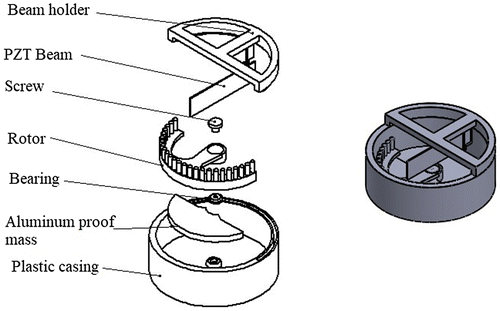
In this assembly, the beam holder ensures the piezoelectric beam stays in place. The proof mass gives weight to the rotor so that it will properly rotate and provide appropriate force to the PZT beam. The plastic casing protects all the components in the assembly while the rotor is responsible to pluck the PZT beam.
As plucking by the rotor will cause vibrational motion to the beam and subsequently generate output voltage, it is important to ensure that the rotor will be able to pluck the beam effectively. We have considered six different rotor geometries with varying radius between the centre of its poles and centre of rotation for this study. Simulations have been carried out to investigate the effect of using these different geometries in generating the output voltage. Table highlights the geometries of all six rotors under consideration and Figure shows the conceptual design of the rotors.
Table 2. Geometries of six different rotors
2.3. Experimental apparatus for voltage output measurement
A series of experiments were carried out to investigate the amount of voltage that could be generated by the fabricated energy harvesting device. The apparatus include a shaker to vibrate the PZT beam of the device, an amplifier to set the gain for the shaker, a function generator to set the frequency and amplitude of the shaker, an Arduino Uno microcontroller to acquire the output signals from the PZT beam as well a digital multimeter to display the voltage output.
The device was mounted on top of the shaker and the frequency of vibration was set to 18 Hz to replicate the human low frequency motion (from activities such as walking) that can vary between 0.1 and a maximum of 25 Hz (Graham, Citation2000). The amplifier gain was set to 1.5 while 5 V input was supplied to the Arduino Uno. To ensure that the device only receives vibration input from the shaker, the shaker was positioned on top of a sturdy platform. Data were gathered for all six types of different rotors. The experimental setup is as shown in Figure .
3. Results and discussion
The experiment described in the previous section has been conducted by using six types of rotors which each has a difference in the gap between its poles and also different radius between the centres of the pole to the centre of rotation as described in Table . The resulting output voltages which have been generated when these rotors with different dimensions are used are described in Table and in Figure . The overall gathered data-set are as attached in Appendices 1 and 2.
Table 3. Output voltage generated for different rotor dimensions
Figure 8. Bar graph showing the comparison of the mean and maximum values for the generated output voltage.
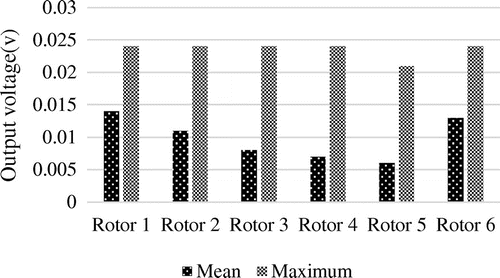
There are two important factors of the rotor design which need to be emphasized in order to maximize the generated output voltage from this rotational piezoelectric energy harvester. The first factor for consideration is the radius between the centre of the pole and the centre of rotation. The second factor is the gap between each pole as shown in Figure . The principle of operation of this rotational piezoelectric energy harvester is based on plucking of the piezoelectric beam by the rotor which results in vibration of the piezoelectric beam and as a result output voltage is generated. Figure shows a comparison of the output voltages generated for these different configurations.
By comparing the output voltage generated by the configurations based on Rotor 1 and Rotor 2, the mean output voltages generated were 0.014 and 0.013 V respectively. The only difference between the geometry of Rotor 1 and Rotor 2 is the gap between the poles where the gap between the poles for Rotor 1 is 1 mm whereas the gap between the poles for Rotor 2 is 3 mm. The smaller gap between the poles for Rotor 1 results in increased plucking frequency of the piezoelectric beam and subsequently increased vibration of the piezoelectric beam and higher output voltage being generated compared to the configuration based on Rotor 2 which has a larger gap between its poles. A similar finding can be observed by comparing the output voltages generated by the configurations based on Rotor 4 and Rotor 6. The lower gap between the poles for Rotor 6 also results in increased plucking of the piezoelectric beam which results in higher output voltage being generated compared to the configuration based on Rotor 6 although both these configurations have the same radius between the centre of the pole and the centre of the axis of rotation.
We observed that the maximum voltage outputs produced by all six rotors were not as distinctive as expected. However, the differences between the mean output voltages were clearly evident and it could be seen in Table that the highest mean voltage generated was 0.014 V when Rotor 1 was used. This indicates that most of the time when the energy harvester was in operation, the voltage generated was within 0.006 to 0.014 V (depending on which rotor that was used). The output voltage will occasionally reach up to 0.024 V when the piezoelectric beam assembly was plucked at its highest frequency during the vibration motion by the shaker.
It can be seen that there was a huge difference between simulated and experimental result in terms of the output voltage. During the experiment, only frequency of the shaker was known, but the frequency of the beam was not. There is a possibility that voltage could not reach the desired target due to low frequency of the beam. Therefore, the next step is to produce and measure the desired frequency, for example using digital tachometer.
Another approach is to employ instrumentation amplifier in order to increase the voltage supply. However, that will require another voltage supply and thus defeat the purpose. Alternatively, the harvested energy can be accumulated and stored by using a supercapacitor. Supercapacitors store much higher energy than conventional capacitors and rechargeable batteries due to its large surface area and small distance between plates. However, due to its high self-discharge rates, it is critical to ensure continuous availability of the source vibration, which will also be our next research interest.
We also found that the PZT-5H bimorph beam that was used for the experiment was too stiff that the plucking did not happen the way it was intended. Thus, in the future, we would like to explore comparing the performance using other piezoelectric materials with less stiffness such as polymers, beams with different dimensions and shape, as well as different plucking techniques.
4. Conclusions and future works
The developed rotational piezoelectric energy harvester has produced a maximum voltage output of 0.024 V, which is approximately 0.8% of mean voltage required to operate a wearable device. The generated voltage output, although seemingly low, has shown that production of clean energy from the low frequency human motion is highly feasible. Further upgrades could be conducted to boost the voltage output by utilizing an operational amplifier with a high gain and combining with other energy harvesting techniques such as electromagnetic. In order to able to achieve a high voltage, we also aim to reduce the resonant frequency by utilizing and optimizing the proof mass. The next stage of this research work will concentrate on integrating supercapacitor to store the voltage into the system to improve the output. The selection of piezoelectric material and plucking techniques will also be reconsidered in optimizing the output based on its reaction to the frequency of vibration.
At this current stage, the fabricated piezoelectric energy harvester may seem a little bulky for wearable devices applications. It may still be suitable to be attached on the knee or thigh, but to ensure users’ comfort when utilizing the device; this prototype shall undergo further developments in making it more compact. By implementing the dual harvester technique (piezoelectric and electromagnetic), the size of the device could be appreciably reduced by decreasing the length of the piezoelectric beam. Through this implementation, a compact sized energy harvesting device could be produced without compromising its electrical power output.
Supplementary material
Supplementary material for this article can be accessed here https://doi.org/10.1080/23311916.2018.1430497.
Funding
This work was supported by the IIUM Research Initiative Grant Scheme [RIGS16-071-0235].
Acknowledgements
The authors would like to thank the Smart Structures, Systems and Control Research Laboratory (S3C RL) of International Islamic University Malaysia for supporting this research work.
Additional information
Notes on contributors
Noor Hazrin Hany Mohamad Hanif
Noor Hazrin Hany Mohamad Hanif received her PhD in Electronics and Electrical Engineering from the University of Southampton, United Kingdom and she is currently an Assistant Professor at the Mechatronics Engineering Department of International Islamic University Malaysia. Presently she is doing research in the areas of rehabilitation robotics, energy harvesting as well as wearable devices.
Ahmad Jazlan Mohaideen
Ahmad Jazlan graduated with a PhD in Control Systems Engineering from the University of Western Australia and is currently an Assistant Professor at the International Islamic University Malaysia.
Huda Azam
Huda Azam obtained her Master’s degree in Mechatronics engineering from the International Islamic University Malaysia, and is currently a research assistant there.
Mas Ehsan Rohaimi
Mas Ehsan Rohaimi has recently received his BEng (Hons.) in Mechatronics Engineering from the International Islamic University Malaysia.
The energy harvesting technique reported in this paper is useful for various applications including wearable devices as well as self-powered mobile sensors.
References
- Apple Inc . (2017). Apple watch series 2 - technical specifications .
- Duun, S. B. , Haahr, R. G. , Birkelund, K. , & Thomsen, E. V. (2010). A ring-shaped photodiode designed for use in a reflectance pulse oximetry sensor in wireless health monitoring applications. IEEE Sensors Journal , 10 (2), 261–268.10.1109/JSEN.2009.2032925
- Graham, B. B. (2000). Using an accelerometer sensor to measure human hand motion . Massachusetts Institute of Technology. Retrieved from http://www-mtl.mit.edu/researchgroups/MEngTP/Graham_Thesis.pdf
- Haahr, R. G. , Duun, S. B. , Toft, M. H. , Belhage, B. , Larsen, J. , Birkelund, K. , & Thomsen, Erik V. (2012). An electronic patch for wearable health monitoring by reflectance pulse oximetry. IEEE Transactions on Biomedical Circuits and Systems , 6 (1), 45–53.10.1109/TBCAS.2011.2164247
- Halim, M. A. , & Park, J. Y. (2017). Piezoelectric energy harvester using impact-driven flexible side-walls for human-limb motion. Microsystem Technologies , 1–9 , doi:10.1007/s00542-016-3268-6
- Jia, Y. , & Seshia, A. A. (2016). Power Optimization by Mass Tuning for MEMS Piezoelectric Cantilever Vibration Energy Harvesting. Journal of Microelectromechanical Systems , 25 (1), 108–117.10.1109/JMEMS.2015.2496346
- Kalantarian, H. , Sideris, C. , Mortazavi, B. , Alshurafa, N. , & Sarrafzadeh, M. (2017). Dynamic computation offloading for low-power wearable health monitoring systems. IEEE Transactions on Biomedical Engineering , 64 (3), 621–628. doi:10.1109/TBME.2016.2570210
- Kim, S.-G. , Priya, S. , & Kanno, I. (2012). Piezoelectric MEMS for energy harvesting. MRS Bulletin , 37 (11), 1039–1050. doi:10.1557/mrs.2012.275
- Koh, A. , Kang, D. , Xue, Y. , Lee, S. , Pielak, R. M. , Kim, J. , … Bastien, P. (2016). A soft, wearable microfluidic device for the capture, storage, and colorimetric sensing of sweat. Science Translational Medicine , 8 (366), 1–13.
- Kuang, Y. , Yang, Z. , & Zhu, M. (2016). Design and characterisation of a piezoelectric knee-joint energy harvester with frequency up-conversion through magnetic plucking. Smart Materials and Structures , 25 (8), 085029. doi:10.1088/0964-1726/25/8/085029
- Li, H. , Mu, X. , Yang, Y. , & Mason, A. J. (2014). Low power multimode electrochemical gas sensor array system for wearable health and safety monitoring. IEEE Sensors Journal , 14 (10), 3391–3399.10.1109/JSEN.2014.2332278
- Mallick, D. , Amann, A. , & Roy, S. (2017). High figure of merit nonlinear microelectromagnetic energy harvesters for wideband applications. Journal of Microelectromechanical Systems , 26 (1), 273–282.10.1109/JMEMS.2016.2636164
- Mansourkiaie, F. , Ismail, L. S. , Elfouly, T. M. , & Ahmed, M. H. (2017). Maximizing lifetime in wireless sensor network for structural health monitoring with and without energy harvesting. IEEE Access , 5 , 2383–2395. doi:10.1109/ACCESS.2017.2669020
- Mayrhofer, P. M. , Rehlendt, C. , Fischeneder, M. , Kucera, M. , Wistrela, E. , Bittner, A. , & Schmid, U. (2017). ScAlN MEMS cantilevers for vibrational energy harvesting purposes. Journal of Microelectromechanical Systems , 26 (1), 102–112.10.1109/JMEMS.2016.2614660
- Mitcheson, P. D. , Yeatman, E. M. , Rao, G. K. , Holmes, A. , & Green, T. C. (2008). Energy harvesting from human and machine motion for wireless electronic devices. Proceedings of the IEEE , 96 (9), 1457–1486.10.1109/JPROC.2008.927494
- Pillatsch, P. , Yeatman, E. M. , & Holmes, A. S. (2012). A scalable piezoelectric impulse-excited energy harvester for human body excitation. Smart Materials and Structures , 21 (11), 115018.10.1088/0964-1726/21/11/115018
- Pillatsch, P. , Yeatman, E. M. , & Holmes, A. S. (2013). A wearable piezoelectric rotational energy harvester . 2013 IEEE International Conference on Body Sensor Networks, BSN 2013, (1). doi:10.1109/BSN.2013.6575470
- Pillatsch, P. , Yeatman, E. M. , & Holmes, A. S. (2014). A piezoelectric frequency up-converting energy harvester with rotating proof mass for human body applications. Sensors and Actuators A: Physical , 206 , 178–185.10.1016/j.sna.2013.10.003
- Pozzi, M. , Almond, H. J. , Leighton, G. J. , & Morirarty, R. J. (2015). Low-profile and wearable energy harvester based on plucked piezoelectric cantilevers . In Proceedings of SPIE 9517, Smart Sensors, Actuators, and MEMS VII; and Cyber Physical Systems (Vol. 9517), Barcelona.
- Prakash, G. R. , Swamy, K. M. V. , Huddar, S. , & Sheeparamatti, B. G. (2012). Study of effect on resonant frequency of piezoelectric unimorph cantilever for energy harvesting . Comsol Conference, Bangalore.
- Salvo, P. , Di Francesco, F. , Costanzo, D. , Ferrari, C. , & Trivella, M. G. (2010). A wearable sensor for measuring sweat rate. IEEE Sensors Journal , 10 (10), 1557–1558.10.1109/JSEN.2010.2046634
- Seiko Watch Cooperation . (2017). Our clean energy watches – kinetic . Retrieved from http://www.seiko-cleanenergy.com/watches/kinetic-1.html
- Soh, P. J. , & Vandenbosch, G. A. E. (2015). Wearable wireless health monitoring: Current developments, challenges, and future trends. IEEE Microwave Magazine , 16 (4), 55–70.10.1109/MMM.2015.2394021
- von Buren, T. , Mitcheson, P. D. , Green, T. C. , Yeatman, E. M. , Holmes, A. S. , & Troster, G. (2006). Optimization of inertial micropower generators for human walking motion. IEEE Sensors Journal , 6 (1), 28–38.10.1109/JSEN.2005.853595
- Yun, J. , Patel, S. N. , Reynolds, M. S. , & Abowd, G. D. (2011). Design and performance of an optimal inertial power harvester for human-powered devices. IEEE Transactions on Mobile Computing , 10 (5), 669–683.10.1109/TMC.2010.202


